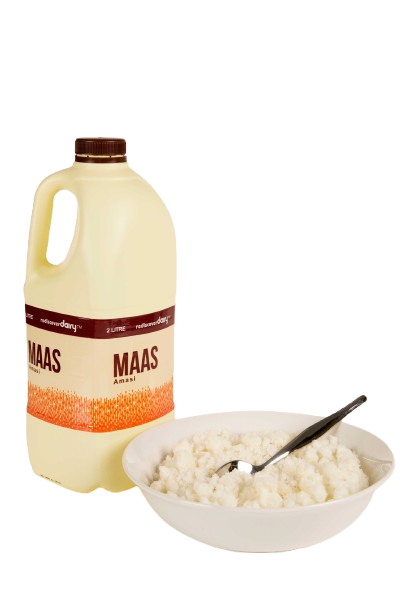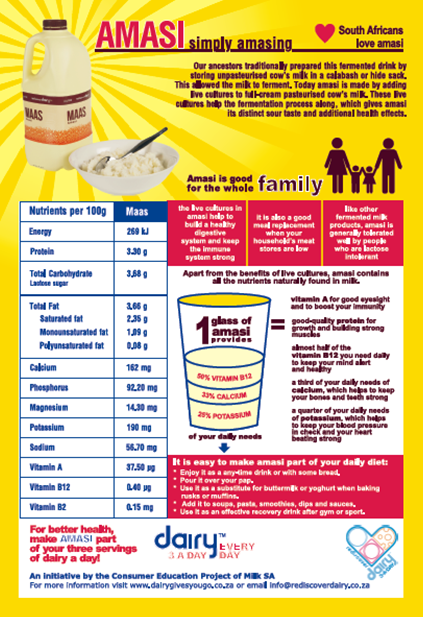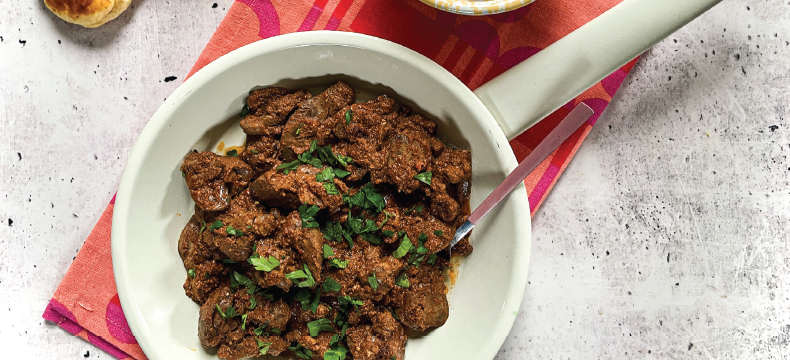
Amasi | Maas
What is Amasi (Maas)?
For those unfamiliar with it, amasi is a fermented milk product, similar in consistency to yoghurt or buttermilk. It has a creamy white colour, a smooth yet thick texture, and a distinct sour taste that many people find refreshing and satisfying.
Fermentation, one of the oldest known methods of food preservation, has been used for centuries to extend the shelf life of foods like dairy, cereals, and vegetables. This process, originally discovered by accident, remains at the heart of how maas is made today.
In modern production, full-cream pasteurised cow’s milk is fermented using naturally occurring or added live bacterial cultures. These live cultures initiate and support fermentation, giving amasi its sour taste and contributing to its health benefits.
Why Amasi is good for the whole family
Amasi is a nutrient-dense, wholesome food that benefits people of all ages. Some of its standout health benefits include:
- Supports digestive health – The live cultures in amasi contribute to a healthy gut microbiome and support immune function.
- Lactose-friendly – Like other fermented milk products, amasi is generally well tolerated by people with lactose intolerance.
- A nutritious meal replacement – Amasi provides high-quality protein and can serve as a meat alternative during times of food insecurity. Simply pair it with phuthu pap for a satisfying, balanced meal.
Packed with nutrients
In addition to its live cultures, amasi retains all the essential nutrients naturally found in milk. A single glass of amasi delivers:
- One-third of your daily calcium needs – for strong bones and teeth.
- Nearly half of your daily vitamin B12 – essential for cognitive function and nerve health.
- A quarter of your daily potassium – important for regulating blood pressure and heart health.
- High-quality protein – supports growth and muscle development.
- Vitamin A – promotes good vision and supports immune function.
| Nutritional Composition of Maas (per 100 g) | |
| Nutrient per 100 g | Maas |
| Energy (kJ) | 269 |
| Protein (g) | 3.3 |
| Total Carbohydrate (g) | 4.61 |
| Lactose sugar (g) | 3.68 |
| Fat (g) | 3.66 |
| Saturated fat (g) | 2.35 |
| Monounsaturated fat (g) | 1.09 |
| Polyunsaturated fat (g) | 0.08 |
| Calcium (mg) | 162 |
| Phosphorus (mg) | 92.2 |
| Magnesium (mg) | 14.3 |
| Potassium (mg) | 190 |
| Sodium (mg) | 56.7 |
| Vitamin A (µg) | 37.5 |
| Vitamin B12 (µg) | 0.4 |
| Vitamin B2 (mg) | 0.15 |
Endorsed by National Dietary Guidelines of South Africa
South Africa is one of over 100 countries that issue national food-based dietary guidelines to promote public health and reduce all forms of malnutrition. One of these guidelines states:
“Have milk, maas or yoghurt every day.”
This recommendation highlights the official recognition of amasi as a valuable part of a balanced diet for all South Africans, helping to prevent nutrient deficiencies and reduce the risk of lifestyle diseases such as heart disease, hypertension, diabetes, and certain cancers.
Health benefits of fermented dairy products
The fermentation process produces organic acids, primarily lactic acid, which lower the pH of the milk to around 4.29. This acidity:
- Helps preserve the product by preventing the growth of spoilage microorganisms.
- Extends shelf life – Amasi lasts up to 21 days when stored at 4˚C.
- Slows gastric emptying, which helps manage blood sugar levels, reduces hunger, and promotes satiety.
Fermented dairy like amasi is also an excellent vehicle for probiotic delivery. Probiotics in fermented milk have been shown to improve lipid profiles and support cardiovascular health.
The high potassium and relatively low sodium content of amasi contributes to a low sodium-to-potassium ratio, which is beneficial for reducing blood pressure and lowering the risk of cardiovascular disease—in line with World Health Organization (WHO) recommendations.
Finally, the reduced lactose content (due to its conversion by lactic acid bacteria) makes amasi more easily digestible for people with lactose intolerance.
Incorporating Amasi into your daily diet
Amasi is incredibly versatile and easy to enjoy. Here are some delicious and practical ways to include it in your meals:
- Drink it as is, or enjoy with bread for a simple meal.
- Pour it over phuthu pap – a traditional favourite.
- Use it as a substitute for buttermilk or yoghurt in baking recipes like muffins and rusks.
- Blend it into soups, smoothies, sauces, dips, or pasta dishes.
- Recover post-workout – its protein content makes it an ideal recovery drink.
- Make a creamy dip using amasi and your choice of herbs and spices.
For Better Health, Include Amasi as One of Your Three Servings of Dairy a Day!
Amasi is not just a culturally rich and tasty food—it’s a nutritious, affordable, and versatile option for maintaining good health. Make it part of your family’s daily routine for a stronger, healthier lifestyle.
Other sources of calcium include sardines, salmon, spinach, cabbage, broccoli and beans.










